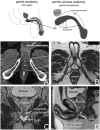Radiation dose-volume effects and the penile bulb
- PMID: 20171507
- PMCID: PMC4786051
- DOI: 10.1016/j.ijrobp.2009.04.094
Radiation dose-volume effects and the penile bulb
Abstract
The dose, volume, and clinical outcome data for penile bulb are reviewed for patients treated with external-beam radiotherapy. Most, but not all, studies find an association between impotence and dosimetric parameters (e.g., threshold doses) and clinical factors (e.g., age, comorbid diseases). According to the data available, it is prudent to keep the mean dose to 95% of the penile bulb volume to <50 Gy. It may also be prudent to limit the D70 and D90 to 70 Gy and 50 Gy, respectively, but coverage of the planning target volume should not be compromised. It is acknowledged that the penile bulb may not be the critical component of the erectile apparatus, but it seems to be a surrogate for yet to be determined structure(s) critical for erectile function for at least some techniques.
Copyright 2010 Elsevier Inc. All rights reserved.
Conflict of interest statement
Conflict of interest: All other authors have no conflict of interest.
Figures


Similar articles
-
Evaluating the relationship between erectile dysfunction and dose received by the penile bulb: using data from a randomised controlled trial of conformal radiotherapy in prostate cancer (MRC RT01, ISRCTN47772397).Radiother Oncol. 2006 Sep;80(3):355-62. doi: 10.1016/j.radonc.2006.07.037. Epub 2006 Sep 1. Radiother Oncol. 2006. PMID: 16949694 Clinical Trial.
-
There is no correlation between erectile dysfunction and dose to penile bulb and neurovascular bundles following real-time low-dose-rate prostate brachytherapy.Int J Radiat Oncol Biol Phys. 2009 Apr 1;73(5):1468-74. doi: 10.1016/j.ijrobp.2008.06.1946. Epub 2008 Oct 14. Int J Radiat Oncol Biol Phys. 2009. PMID: 18922652
-
Radiation dose delivered to the proximal penis as a predictor of the risk of erectile dysfunction after three-dimensional conformal radiotherapy for localized prostate cancer.Int J Radiat Oncol Biol Phys. 2004 Dec 1;60(5):1357-63. doi: 10.1016/j.ijrobp.2004.05.030. Int J Radiat Oncol Biol Phys. 2004. PMID: 15590165
-
Radiation therapy for prostate cancer and erectile (dys)function: the role of imaging.Acta Oncol. 2005;44(7):673-8. doi: 10.1080/02841860500326190. Acta Oncol. 2005. PMID: 16227156 Review.
-
Erectile dysfunction after radiotherapy for prostate cancer and radiation dose to the penile structures: a critical review.Radiother Oncol. 2007 Aug;84(2):107-13. doi: 10.1016/j.radonc.2007.07.018. Epub 2007 Aug 20. Radiother Oncol. 2007. PMID: 17707936 Review.
Cited by
-
Erectile Dysfunction in Male Survivors of Childhood Cancer-A Report From the Childhood Cancer Survivor Study.J Sex Med. 2016 Jun;13(6):945-54. doi: 10.1016/j.jsxm.2016.03.367. Epub 2016 Apr 21. J Sex Med. 2016. PMID: 27117527 Free PMC article.
-
Initial results for patient setup verification using transperineal ultrasound and cone beam CT in external beam radiation therapy of prostate cancer.Radiat Oncol. 2016 Nov 8;11(1):147. doi: 10.1186/s13014-016-0722-7. Radiat Oncol. 2016. PMID: 27825386 Free PMC article.
-
Prostate cancer radiotherapy and incidental testicular irradiation: Impact on gonadal function.Clin Transl Radiat Oncol. 2023 Mar 8;40:100611. doi: 10.1016/j.ctro.2023.100611. eCollection 2023 May. Clin Transl Radiat Oncol. 2023. PMID: 36942089 Free PMC article.
-
A pooled long-term follow-up after radiotherapy for prostate cancer with and without a rectal hydrogel spacer: impact of hydrogel on decline in sexual quality of life.Front Oncol. 2023 Oct 11;13:1239104. doi: 10.3389/fonc.2023.1239104. eCollection 2023. Front Oncol. 2023. PMID: 37886176 Free PMC article.
-
Impact of transperineal ultrasound on perineal skin dose in prostate radiation therapy.Tech Innov Patient Support Radiat Oncol. 2022 Aug 27;23:27-32. doi: 10.1016/j.tipsro.2022.08.003. eCollection 2022 Sep. Tech Innov Patient Support Radiat Oncol. 2022. PMID: 36090010 Free PMC article.
References
-
- Sanda MG, Dunn RL, Michalski J, et al. Quality of life and satisfaction with outcome among prostate-cancer survivors. N Engl J Med. 2008;358:1250–1261. - PubMed
-
- Robinson JW, Moritz S, Fung T. Meta-analysis of rates of erectile function after treatment of localized prostate carcinoma. Int J Radiat Oncol Biol Phys. 2002;54:1063–1068. - PubMed
-
- Rosen RC, Riley A, Wagner G, et al. The international index of erectile function (IIEF): A multidimensional scale for assessment of erectile dysfunction. Urology. 1997;49:822–830. - PubMed
-
- Broderick GA. Evidence based assessment of erectile dysfunction. Int J Impot Res. 1998;10(Suppl. 2):S64–S73. discussion S77–S69. - PubMed
-
- Brown MW, Brooks JP, Albert PS, et al. An analysis of erectile function after intensity modulated radiation therapy for localized prostate carcinoma. Prostate Cancer Prostatic Dis. 2007;10:189–193. - PubMed
Publication types
MeSH terms
Grants and funding
LinkOut - more resources
Full Text Sources
Medical

